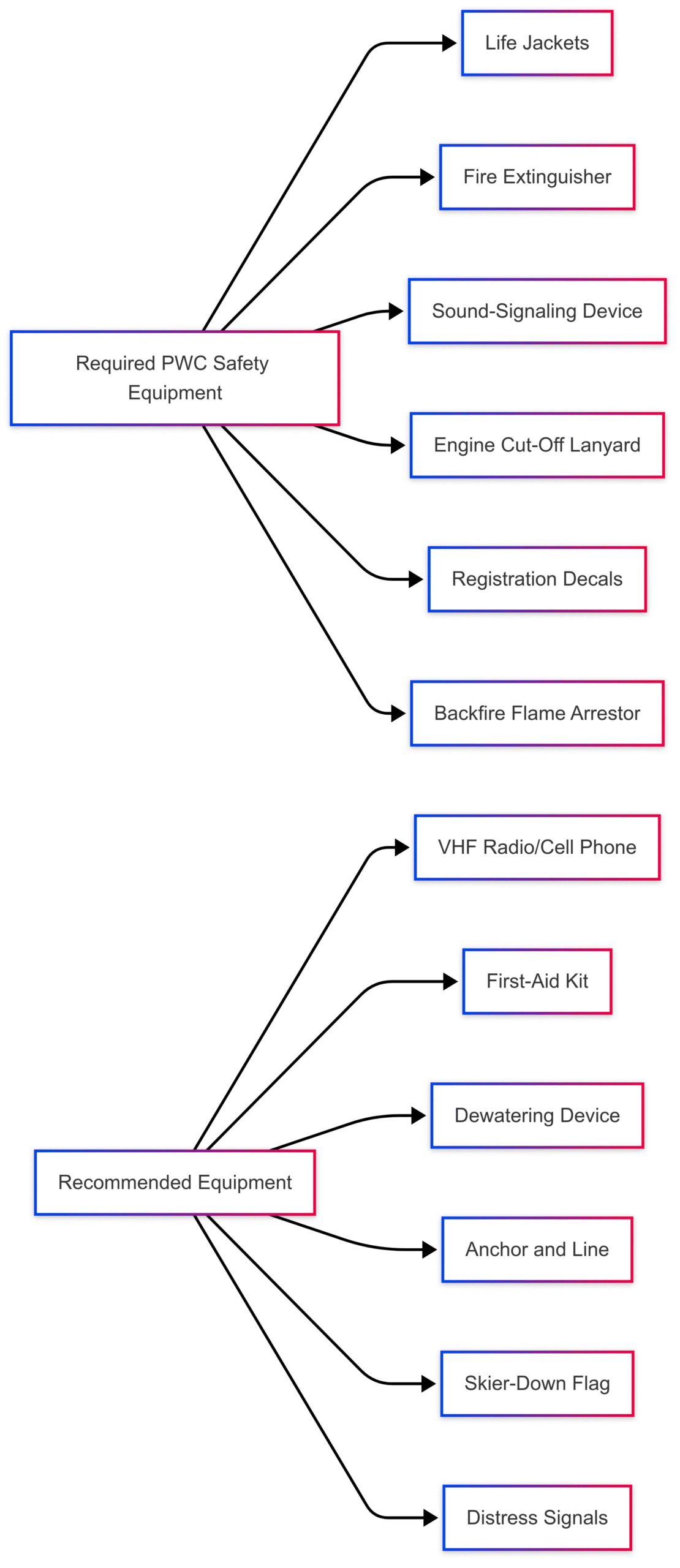Personal Watercraft (PWC) Safety Guide
Master PWC safety with our comprehensive guide. Learn essential tips, required equipment, and regulations for safe Jet Ski, WaveRunner, or Sea-Doo riding.
Personal watercraft (PWC), commonly known by brand names like Jet Ski, WaveRunner, or Sea-Doo, have surged in popularity, offering thrilling experiences on the water. With over one million PWCs in use today, they account for a significant portion of new boat sales. However, their unique design, high maneuverability, and powerful jet propulsion systems demand respect and responsibility from operators. This comprehensive guide explores every aspect of PWC safety, from pre-ride preparations to on-water practices, required equipment, and environmental considerations. Whether you’re a seasoned rider or new to PWCs, these insights will help ensure a safe and enjoyable experience.
Understanding Personal Watercraft
PWCs are classified by the U.S. Coast Guard as Class A inboard motor vessels, subject to the same regulations as traditional powerboats. Unlike conventional boats, PWCs rely on a jet pump system, where water is drawn through an intake, propelled by an impeller, and expelled through a nozzle for thrust. This design enables rapid acceleration, tight turns, and high maneuverability, but it also requires specific operational knowledge. For instance, PWCs lose steering control without throttle input, as there’s no rudder to guide the craft when the jet pump is idle.
Modern PWCs have evolved significantly from their stand-up, single-rider origins. Today’s models, like the Yamaha WaveRunner VX Deluxe or Sea-Doo GTI SE, accommodate two to four passengers, offer substantial storage, and feature advanced dashboards with gauges. Some are even capable of towing water skiers. However, their compact size and agility can make them less visible to other boaters, increasing the need for cautious operation.
PWC Models and Specifications
Here’s a comparison of popular PWC models to illustrate their capabilities:
| Model | Passenger Capacity | Engine | Top Speed (mph) | Price (USD) | Key Features |
|---|---|---|---|---|---|
| Yamaha WaveRunner VX Deluxe | 3 | 1049cc, 3-cylinder | ~53 | ~$12,299 | Cruise assist, no-wake mode, RiDE system |
| Sea-Doo GTI SE 130 | 3 | 1630cc, 3-cylinder | ~55 | ~$13,599 | Intelligent Brake & Reverse (iBR), sound system |
| Kawasaki Jet Ski Ultra 310LX | 3 | 1498cc, supercharged | ~67 | ~$19,199 | Luxury seating, audio system, cruise control |
Note: Prices are approximate and may vary by region or dealer.
Pre-Ride Preparation: Setting the Stage for Safety
Safety begins long before you hit the water. Proper preparation ensures your PWC is ready, you’re equipped, and you’re aware of the rules.
Familiarize Yourself with the PWC
Every PWC model has unique handling characteristics. Read the owner’s manual thoroughly to understand controls, safety warnings, and operational limits. Pay special attention to the jet pump system, throttle, and steering. Practice in a calm, open area to master turns, stops, and, if applicable, reverse operation. For example, models like the Sea-Doo GTI SE feature an Intelligent Brake and Reverse (iBR) system, which allows for quicker stopping by redirecting thrust.
Complete a Boating Safety Course
Many states require operators to complete a boating safety course, especially for those under 18. These courses, offered by organizations like Boat-Ed, cover PWC-specific topics such as steering dynamics, reboarding techniques, and local regulations. Completing a course not only ensures compliance but also boosts confidence and competence.
Gear Up Properly
Proper gear is critical for safety and comfort:
- Life Jacket: A U.S. Coast Guard-approved life jacket (Type I, II, or III) is mandatory for all riders and towed individuals. Ensure a proper fit—snug but not restrictive.
- Safety Lanyard: The engine cut-off switch lanyard must be attached to the operator’s wrist or life jacket. It stops the engine if you fall off, preventing the PWC from continuing uncontrolled.
- Protective Clothing: Wear neoprene shorts or a wetsuit to protect against high-speed water impact. Gloves and non-slip footwear enhance grip, while goggles or wraparound sunglasses shield eyes from spray and wind.
- Helmet: Consider a helmet for high-speed riding to reduce the risk of head injuries, which are common in PWC accidents.
Conduct a Pre-Ride Inspection
A thorough inspection prevents mechanical issues on the water. Check the following:
- Battery: Ensure it’s fully charged and connections are secure.
- Controls: Test the throttle, steering, and stop button.
- Fuel and Oil: Fill the tank, check for leaks, and follow the “1/3 rule” (1/3 to go out, 1/3 to return, 1/3 reserve).
- Hull and Jet Pump: Inspect for damage and ensure the jet pump intake is clear of debris.
- Drain Plug: Secure the plug to prevent flooding.
- Safety Gear: Verify you have all required equipment (see below).
Check Weather and Conditions
Avoid riding in adverse weather, such as high winds or storms, which can create hazardous conditions. Check local forecasts and tide charts, especially in coastal areas where low tides expose shallow waters or sensitive ecosystems.
On-Water Safety Practices
Once on the water, vigilance and adherence to best practices are key to avoiding accidents and ensuring a fun experience.
Stay Alert and Aware
Constant awareness of your surroundings is critical. PWCs are small and fast, making them harder for other boaters to spot. Scan for other vessels, swimmers, and obstacles, and look behind you before turning to avoid collisions with overtaking boats. Maintain a safe distance from other watercraft, shorelines, and swimmers—typically at least 100 feet in busy areas.
Maintain Safe Speeds
Adjust your speed based on conditions, traffic, and visibility. In crowded areas or near shorelines, reduce speed to minimize wake and avoid collisions. Follow posted speed limits and no-wake zones, which protect swimmers and prevent shoreline erosion. For example, the Yamaha WaveRunner’s no-wake mode simplifies maintaining low speeds in restricted areas.
Avoid Risky Maneuvers
High-risk actions like wake-jumping, racing, or spraying others are not only dangerous but often illegal. These maneuvers increase the likelihood of falls, which can result in injuries or collisions. If you fall, release the handlebars and swim clear of the PWC to avoid injury. Reboard only with the engine off, following the manufacturer’s instructions to right a capsized craft.
Operate During Daylight
PWCs lack navigation lights and are prohibited from operating between sunset and sunrise in most areas. Night riding increases the risk of falls and collisions due to low visibility and the craft’s exposed design.
Required and Recommended Safety Equipment
PWCs must carry specific equipment to comply with U.S. Coast Guard regulations, with additional gear enhancing safety.
Required Equipment
- Life Jackets: One Coast Guard-approved life jacket per person, including towed individuals.
- Fire Extinguisher: A marine-rated B-1 fire extinguisher, accessible and in working condition.
- Sound-Signaling Device: A whistle or horn for signaling in emergencies.
- Engine Cut-Off Lanyard: Attached to the operator at all times.
- Registration and Decals: Displayed as per state requirements.
- Backfire Flame Arrestor and Ventilation System: Ensures safe engine operation.
Recommended Equipment
- VHF Radio or Cell Phone: For emergency communication, stored in a waterproof case.
- First-Aid Kit: Includes bandages, antiseptic, and burn cream.
- Dewatering Device: A hand-operated bilge pump for removing water.
- Anchor and Line: Useful for securing the PWC in open water.
- Skier-Down Flag: Required in some states when towing.
- Distress Signals: Flares, an orange flag, or a signal mirror for daytime emergencies.
Equipment Checklist

Environmental Responsibility
PWCs can impact delicate aquatic ecosystems if not operated responsibly. Follow these guidelines to minimize your environmental footprint:
Avoid Pollution
Refuel on land using absorbent pads to catch spills. Check and clean the engine away from shorelines to prevent oil or fuel from harming aquatic life. Overfilling the tank can lead to spills that disrupt the food chain by affecting microorganisms.
Minimize Turbidity
In shallow waters (less than 3 feet), operate at idle speed to avoid stirring up sediments, which can reduce light penetration and deplete oxygen, harming fish and birds. Avoid sea grass beds and mangrove channels, which serve as nurseries for marine life.
Protect Wildlife and Vegetation
Steer clear of posted wildlife areas, such as bird nesting sites or habitats for endangered species like manatees, sea otters, or brown pelicans. Excessive wake can erode shorelines, damaging habitats for plants and animals. Operate in marked channels to minimize disturbance.
PWC Environmental Impact Flowchart

Legal and Operational Requirements
PWCs must comply with federal and state regulations, which vary by region. Key requirements include:
- Registration: PWCs must be registered with the state, displaying proper numbers and decals.
- Capacity Limits: Adhere to the manufacturer’s passenger and weight limits, found on the capacity plate or in the manual.
- Age Restrictions: Many states require operators to be at least 16 or have adult supervision.
- Boating Education: Some states mandate a safety course or license for operators.
- No-Wake Zones: Operate at idle speed in designated areas to protect swimmers and shorelines.
Check local laws for specific restrictions, such as bans on PWCs in certain lakes or time-based limitations.
Preventing Accidents
The leading cause of PWC accidents is collisions, often with other PWCs or objects. To reduce risks:
- Maintain a Proper Lookout: Constantly scan for other vessels, swimmers, and obstacles. Larger boats may not see you, so assume the right of way and give them space.
- Operate at Safe Speeds: High speeds increase stopping distances (up to 250 feet or more). Use features like the Sea-Doo iBR for quicker deceleration when needed.
- Educate Borrowers: Ensure anyone operating your PWC knows the rules and controls. Rental PWCs have higher accident rates due to inexperienced operators.
PWC Etiquette and Code of Ethics
The rapid rise in PWC use has led to complaints about noise, wake, and environmental impact. The Personal Watercraft Industry Association’s Code of Ethics promotes responsible operation:
- Respect other waterway users and adjacent property owners.
- Use launch ramps efficiently to avoid delays.
- Follow navigation rules and avoid wake-jumping.
- Maintain safe distances from other vessels and shorelines.
- Operate at idle speed in no-wake zones.
- Avoid disturbing wildlife or sensitive areas.
- Minimize noise by avoiding high-speed operation near shorelines.
- Volunteer assistance in emergencies.
Adhering to these principles reduces conflicts and helps preserve PWC access to waterways.
Emergency Preparedness
Be ready for unexpected situations:
- Communication Devices: Carry a waterproof VHF radio or cell phone to call for help.
- First-Aid Kit: Address minor injuries like cuts or burns.
- Float Plan: Share your trip details with someone onshore, including your route and expected return time.
- Reboarding Practice: Practice reboarding in calm waters, as it can be challenging in rough conditions. Consider a boarding ladder for easier access.
Avoiding Alcohol and Drugs
Operating a PWC under the influence is illegal and dangerous. Alcohol impairs judgment, reaction time, and coordination, increasing the risk of accidents. Save any drinking for after your ride to ensure safety for yourself and others.
The Importance of Boater Education
A boater education course is one of the best investments in PWC safety. Courses from providers like Boat-Ed cover critical topics, including:
- Pre-ride inspections and maintenance.
- Steering and stopping techniques.
- Reboarding a capsized PWC.
- Understanding local regulations.
Certification not only ensures compliance but also equips you with the knowledge to handle challenging situations confidently.
Conclusion
Personal watercraft offer unmatched fun and versatility on the water, but their unique design and capabilities require responsible operation. By familiarizing yourself with your PWC, wearing proper gear, adhering to regulations, and respecting the environment, you can ensure safe and enjoyable rides. Regular maintenance, boater education, and vigilance on the water further reduce risks, allowing you to focus on the thrill of the ride. Whether you’re carving through waves on a Yamaha WaveRunner or cruising on a Sea-Doo, this guide equips you with the knowledge to stay safe and make the most of your PWC adventures.
Happy Boating!
Share Personal Watercraft (PWC) Safety Guide with your friends and leave a comment below with your thoughts.
Read Best Black Friday Deals for Boater until we meet in the next article.






